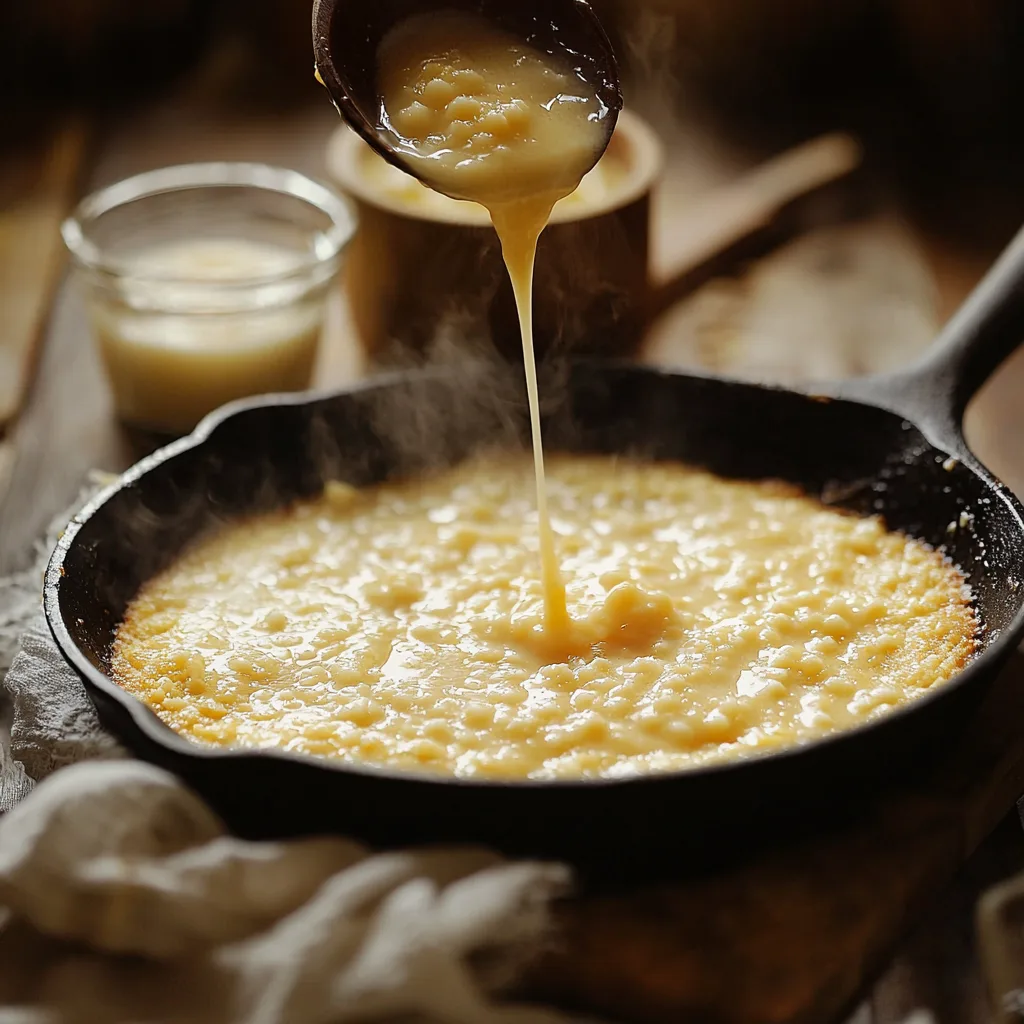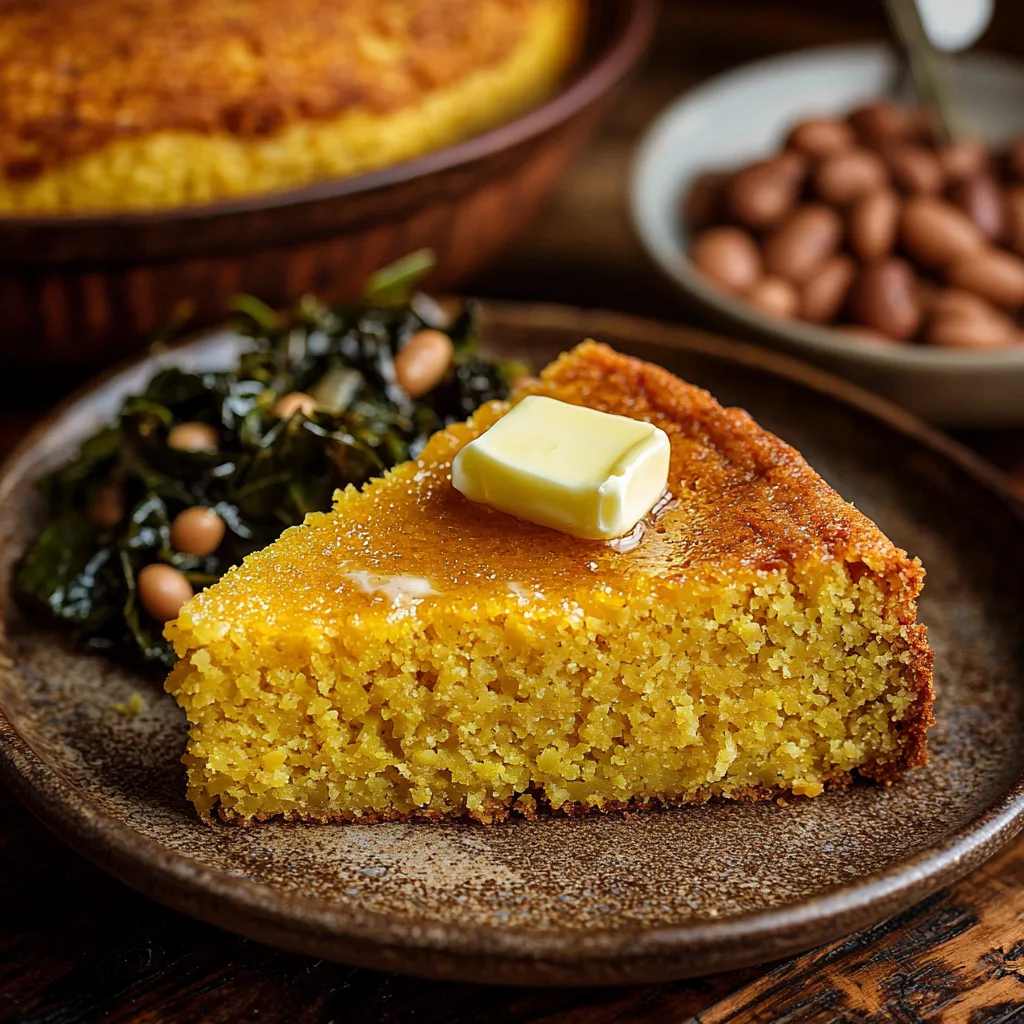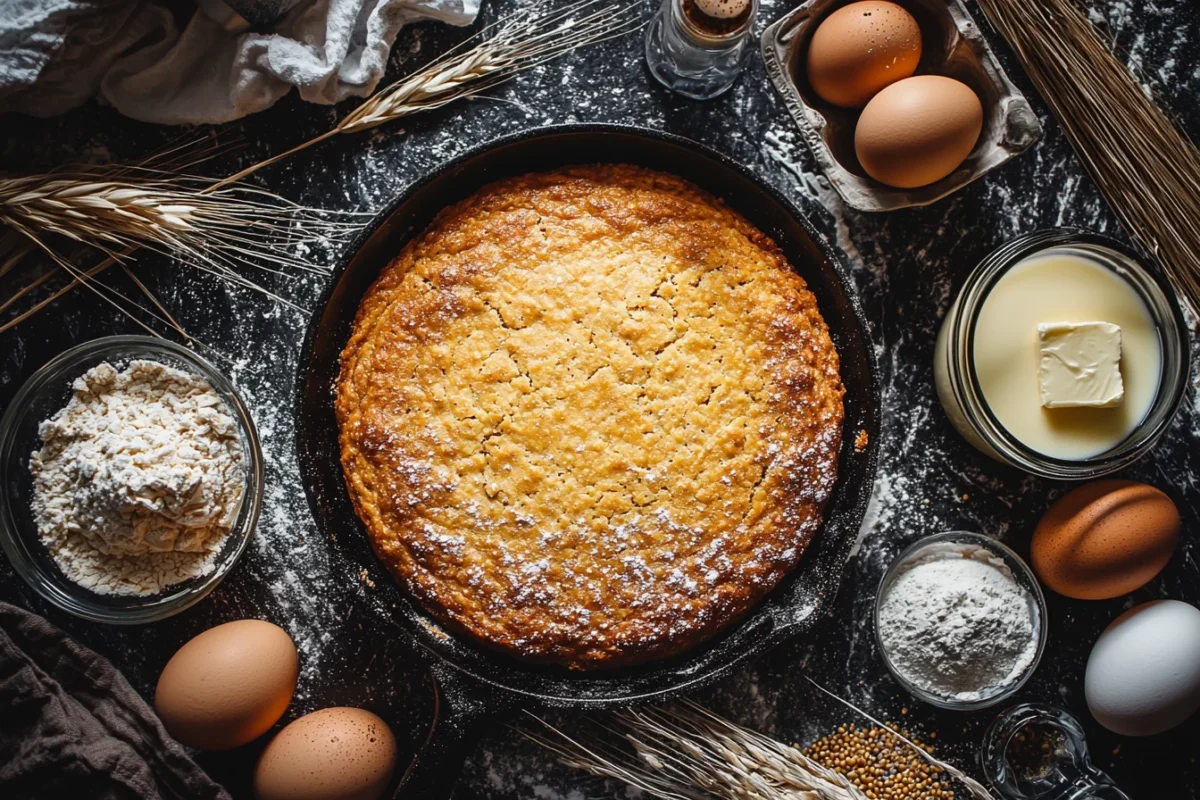Why do Southerners not put sugar in cornbread? It’s a question that sparks passionate debates at dinner tables across the country. For many Southerners, cornbread isn’t just a side dish—it’s a cherished tradition tied to history, culture, and family meals.
Southern cornbread stands out for its bold, savory flavor and crispy texture. Unlike its sweeter Northern counterpart, it focuses on simplicity and natural corn flavors. Generations of Southern cooks crafted this timeless recipe using readily available ingredients. Why do Southerners not put sugar in cornbread? This choice reflects a deep connection to Southern culinary roots and the dish’s purpose as a savory side.
This iconic dish pairs perfectly with hearty meals like beans, greens, and barbecue. Each crumbly slice carries a story, connecting families to their heritage. Whether you’re a lifelong fan or a curious cook, discovering why Southerners do not put sugar in cornbread offers a glimpse into a rich and flavorful tradition.
Table of Contents
The Historical Roots of Southern Cornbread Traditions
Cornbread in Southern Agriculture: A Historical Perspective
Why do Southerners not put sugar in cornbread? The answer lies in Southern agriculture and history. Corn became a dietary staple in the South because it thrived in the region’s hot, humid climate. Early settlers relied on cornmeal as an affordable and versatile ingredient.
Cornbread emerged from practicality, using simple, readily available ingredients like cornmeal, buttermilk, and eggs. It became a staple side dish, offering sustenance to families during hard times. Why do Southerners not put sugar in cornbread? Historically, sugar was considered a luxury, reserved for desserts and special occasions.
The savory profile of cornbread also complements traditional Southern dishes like collard greens, beans, and stews. The lack of sugar enhances its ability to soak up rich, savory flavors. Over time, this approach ingrained itself in Southern culinary identity. Today, Southern cornbread tells a story of resilience, resourcefulness, and cultural traditions with every golden, crumbly bite.
For a deeper dive into how regional preferences shaped cornbread traditions, check out What is the Difference Between Cornbread and Southern Cornbread to better understand the contrast between these two beloved styles.
How Scarcity Shaped Recipes Across Generations
Southern cornbread recipes evolved out of necessity, reflecting the economic realities of the region. Sugar was once considered a luxury item in many Southern households. It was often reserved for desserts and special occasions rather than everyday meals.
In contrast, cornmeal was a reliable and affordable grain, making it a dietary staple. Southern cooks relied on simple ingredients like buttermilk, eggs, and fat to bring their cornbread recipes to life. Southern cooks viewed adding sugar as an unnecessary expense, especially when feeding large families.
Furthermore, the practicality of cornbread meant it needed to pair well with savory dishes. Sugar would have disrupted the balance of flavors, especially when served alongside bold, spiced meats or vegetables. Cornbread became essential because it could stretch ingredients and feed larger families. Why did Southerners not add sugar to cornbread historically? It was often seen as an unnecessary luxury. To this day, Southern cornbread remains a symbol of resourceful cooking practices.
Flavor Preferences in Southern Cuisine
The Savory Appeal of Traditional Cornbread
Authentic Southern cornbread celebrates savory flavors and rustic charm. Unlike its Northern counterpart, which often leans towards sweetness, Southern cornbread keeps things simple. The focus remains on natural cornmeal flavors, enhanced by rich fats like bacon grease or beef tallow.
Savory notes dominate Southern cornbread because of its role as a side dish rather than a standalone treat. Cooks designed it to balance bold, salty, or smoky flavors in dishes like collard greens, chili, or fried chicken. Sweetness would clash with these flavors.
The texture of savory cornbread also enhances its appeal. Its crispy crust and hearty crumb soak up sauces and broths without falling apart. Without sugar, every bite highlights the natural richness of cornmeal, creating a dish rooted in tradition. Cornbread in Southern kitchens retains its bold flavors without added sweetness. Why do Southerners favor savory cornbread? It’s about preserving the natural corn flavor.
How Local Ingredients Influence Taste and Texture
Locally sourced ingredients give Southern cornbread its distinctive flavor. Coarse cornmeal, a regional favorite, creates its signature hearty texture and rustic bite. Learn more about the nutritional value of cornmeal from the USDA. Farmers across the South historically prioritized corn as a versatile, reliable crop. Its bold, earthy flavor defines every slice of traditional cornbread.
In addition, fats like bacon grease or beef tallow often replace butter or vegetable oil in Southern recipes. These fats create savory richness and a smoky undertone, enhancing the bread’s flavor. Buttermilk also plays a crucial role, contributing tanginess and moisture that balance the dense cornmeal beautifully.
Moreover, omitting sugar lets these local flavors shine through naturally. Each bite highlights the careful balance of cornmeal, buttermilk, and savory fats. Local Southern cornmeal provides the hearty base that defines traditional cornbread. Without sugar, each cornbread bite captures the earthy richness of its core ingredients.
The Impact of Cooking Techniques on Cornbread Taste
Perfecting Southern Cornbread Texture with Cast-Iron Cooking
Cooking Southern cornbread in a cast-iron skillet isn’t just a method—it’s a time-honored tradition. This classic technique creates the signature crispy crust that sets Southern cornbread apart from other regional variations. Preheating the skillet before pouring in the batter ensures an instant sizzle, sealing in moisture and flavor.

Cast iron retains heat exceptionally well, allowing the cornbread to bake evenly from edge to center. This consistency prevents soggy bottoms or uneven cooking, resulting in a perfect balance of textures. The skillet’s surface also enhances the crust, giving it a golden-brown finish that’s hard to replicate with regular pans.
Many Southern cooks grease their skillets with bacon fat or beef tallow. This extra step infuses the bread with savory richness, elevating its overall flavor profile. Southern cooks rely on cast-iron skillets to achieve cornbread’s classic crispy edges. The method ensures a golden crust, reflecting the Southern style of cornbread preparation.
The Art of Crisp Southern Cornbread Without Sugar
Time-tested cooking techniques—not added sugar—create the irresistible crispiness of Southern cornbread. Preheating a cast-iron skillet creates an instant sizzle when the batter hits the hot surface. This step locks in moisture while forming a golden, crispy crust.
Next, fats like bacon grease or beef tallow play a vital role in achieving perfect edges. These fats coat the skillet evenly, preventing sticking and adding a deep savory flavor. They also help achieve that golden-brown finish Southern cornbread is famous for.
Additionally, gently mixing the batter ensures the final texture stays light and fluffy on the inside. Overmixing can create a dense crumb that lacks the desired contrast between soft centers and crispy edges. Skill and technique allow Southern cooks to create this balance. By focusing on method instead of sugar, they achieve a timeless texture rooted in tradition and perfected over generations.
Northern vs Southern Cornbread: A Flavor Debate
Key Differences Between Northern and Southern Cornbread
Northern cornbread is known for its slightly sweet and cake-like texture, setting it apart from its Southern counterpart. Sugar is often added to the batter, giving it a dessert-like quality that pairs well with soups, stews, or even served as a standalone treat. This sweetness balances the natural earthiness of the cornmeal, creating a unique flavor profile many people love.
In addition to sugar, Northern recipes often use fine cornmeal. This results in a smoother texture and a more delicate crumb. Butter or vegetable oil is commonly used to add richness and moisture. Unlike Southern cornbread, which relies on skillet baking, Northern versions are often baked in standard pans or muffin tins.
The result is a softer, lighter bread with a subtle sweetness. This style reflects regional preferences and ingredients, showing how cornbread adapts to local culinary traditions. Both versions are equally beloved, despite their differences.
Regional Differences in Cornbread Styles Across the U.S.
Cornbread recipes across the United States reflect strong regional traditions. In Northern regions, cooks often add sugar to create a slightly sweet, cake-like texture. Fine cornmeal gives their recipes a smooth crumb, making them light and airy. These preferences stem from historical ingredient availability and local culinary habits.
In contrast, Southern cornbread follows a savory approach. Coarse cornmeal creates a heartier texture, while fats like bacon grease or beef tallow add depth of flavor. Cast-iron skillets, a Southern kitchen staple, ensure an iconic crispy crust. These elements define Southern-style cornbread and give it a unique identity.
Additionally, local agriculture influenced these regional choices. Northern areas had easier access to refined sugars, while Southern kitchens focused on practical, filling flavors. Cultural and environmental factors shaped these differences in cornbread recipes. Each version tells a story of resilience, adaptation, and culinary pride in every bite.
Cultural Significance of Savory Cornbread in the South
The Cultural Role of Cornbread in Southern Hospitality
In Southern culture, cornbread represents more than just a dish—it symbolizes warmth, hospitality, and tradition. Families often serve it alongside classic meals like collard greens, beans, or barbecue. Its savory flavor and rustic texture bring comfort to every table.

Additionally, cornbread is frequently shared at gatherings, potlucks, and celebrations, where it serves as a centerpiece of community bonding. Recipes are often handed down through generations, preserving family stories and culinary heritage. Every slice carries a sense of belonging, making it an enduring symbol of Southern hospitality and shared traditions.
Furthermore, cornbread’s simplicity reflects Southern values of resourcefulness and practicality. It uses basic ingredients, yet delivers a dish rich in flavor and cultural significance. Whether served warm with butter, crumbled into chili, or paired with hearty dishes, cornbread tells a story of resilience, community, and love in every bite.
Cornbread’s Importance in Southern Social Gatherings
Cornbread holds a central role in Southern gatherings, from casual family dinners to festive holiday feasts. Its versatility makes it a favorite companion for hearty meals, soups, and stews. Warm cornbread often brings people together over conversations and shared stories, creating lasting connections.
At gatherings, cornbread often sparks conversations and creates connections, as it’s tied to cherished memories and cultural pride. In addition, its ability to complement a wide variety of dishes ensures it fits into any occasion seamlessly. It’s a dish that welcomes everyone to the table with a familiar, comforting presence.
Moreover, cornbread’s role in gatherings goes beyond its taste. It serves as a reminder of Southern traditions and the importance of hospitality. Whether it’s served fresh from a cast-iron skillet, paired with smoked meats, or crumbled into a savory dish, cornbread represents the heart of Southern culinary culture, connecting people through flavor, warmth, and enduring traditions.
Modern Takes on Traditional Southern Cornbread
Creative Twists on Southern Cornbread Recipes
Modern Southern cornbread recipes strike a balance between preserving tradition and embracing creative adaptations. While classic versions stick to simple ingredients like cornmeal, buttermilk, and bacon grease, contemporary recipes often introduce exciting additions. Ingredients such as shredded cheese, jalapeños, or fresh herbs bring new layers of flavor to this timeless dish.
In addition, some cooks experiment with alternative cooking fats, like olive oil or coconut oil, offering healthier options without compromising taste. These modern twists cater to changing dietary preferences while still honoring the traditional roots of Southern cornbread.
Furthermore, innovative presentation styles have gained popularity. From mini skillet servings to cornbread muffins, these variations make the dish more versatile for different occasions. Despite the creative changes, the essence of Southern cornbread remains unchanged—it’s warm, comforting, and undeniably satisfying. Whether traditional or modern, each version pays homage to the dish’s enduring legacy.
Regional Adaptations of Traditional Southern Cornbread Recipes
Across the South, cornbread recipes reflect the diversity of local traditions, ingredients, and regional preferences. Some regions prefer a crumbly, dense texture, while others favor a softer, cake-like consistency. These preferences often depend on local crops, cooking methods, and cultural influences passed down through generations.
For example, coastal areas may incorporate fresh seafood like crab into cornbread, creating a savory twist with unique flavors. Inland regions lean towards bold additions like smoked meats or spicy jalapeños, adding depth and personality to the dish. Each variation blends local ingredients with traditional techniques, telling a unique culinary story.
Additionally, modern food trends have inspired Southern cooks to experiment further. Gluten-free cornmeal, dairy-free substitutes, and alternative fats like olive oil now appear in updated recipes. These adaptations allow cornbread to remain inclusive and accessible while maintaining its timeless appeal. Every regional twist highlights the creativity and enduring legacy of Southern cooking traditions.
Frequently Asked Questions (FAQs)
Do southerners put sugar in their cornbread?
Traditionally, Southerners do not add sugar to their cornbread. This preference stems from historical roots when cornbread was a daily staple, not a sweet treat. Southern cornbread focuses on savory flavors, often relying on ingredients like buttermilk and bacon grease for richness. Additionally, the use of coarse cornmeal creates a hearty texture that doesn’t need sugar to shine. For many Southern cooks, adding sugar would disrupt the bread’s rustic and authentic taste. However, modern variations occasionally include a touch of sugar for those who enjoy a slightly sweet twist.
What is the difference between New York cornbread and southern cornbread?
New York-style cornbread often leans sweeter and more cake-like in texture. Sugar is a key ingredient, and finer cornmeal creates a smoother, softer crumb. In contrast, Southern cornbread sticks to its savory roots, focusing on bold, natural corn flavors. Coarse cornmeal gives it a more rustic bite, and it’s traditionally baked in a cast-iron skillet for a crispy crust. Additionally, Southern recipes often include buttermilk and savory fats like bacon grease. While both styles are delicious, the difference lies in sweetness, texture, and cooking techniques. Each version reflects the unique culinary traditions of its region.
Why isn’t southern cornbread sweet?
Southern cornbread avoids sugar because it was originally created as a savory side dish. Historically, Southern households relied on cornbread as an everyday staple, paired with meals like beans, greens, and stews. Sugar was considered a luxury item and wasn’t necessary for cornbread’s purpose. Instead, ingredients like bacon grease, buttermilk, and coarse cornmeal provided rich, savory flavors and hearty texture. Additionally, baking in a cast-iron skillet gave it a signature crispy crust. This approach has endured over generations, preserving the bold, unsweetened flavor profile that defines traditional Southern cornbread.
Can you add sugar to your cornbread mix?
Yes, you can add sugar to your cornbread mix if you prefer a sweeter flavor. While traditional Southern recipes avoid sugar, modern versions often include a small amount for a cake-like texture. Adding sugar balances the cornmeal’s natural earthiness and creates a softer crumb. For those experimenting, start with a tablespoon of sugar and adjust based on your taste. Additionally, you can add honey for a more complex sweetness. Whether sweet or savory, cornbread is versatile and can be customized to suit different preferences. The choice ultimately comes down to personal taste!
Celebrating the Timeless Tradition of Southern Cornbread
Why do Southerners not put sugar in cornbread? It’s a timeless tradition tied to simplicity, history, and community. Every skillet-baked loaf carries stories of family gatherings, shared meals, and the resourcefulness of past generations. Its simple ingredients and bold flavors represent a connection to Southern heritage that goes beyond the dinner table.
Additionally, cornbread remains a versatile dish, adapting effortlessly to changing tastes and preferences. Whether served alongside hearty stews, crumbled into soups, or enjoyed warm with a drizzle of honey, it holds a special place in Southern kitchens. The absence of sugar allows the savory richness of cornmeal, bacon grease, and buttermilk to shine through every bite. Whether paired with greens, soaked in broth, or served on its own, Southern cornbread holds a special place in many hearts. It’s more than just food—it’s a symbol of comfort, resilience, and shared tradition passed down through generations.

